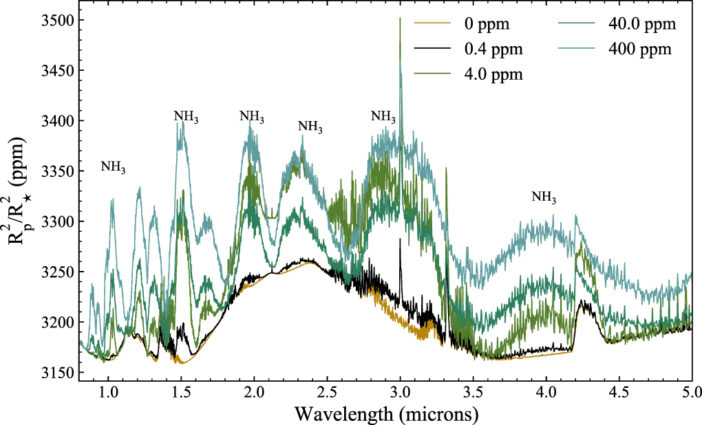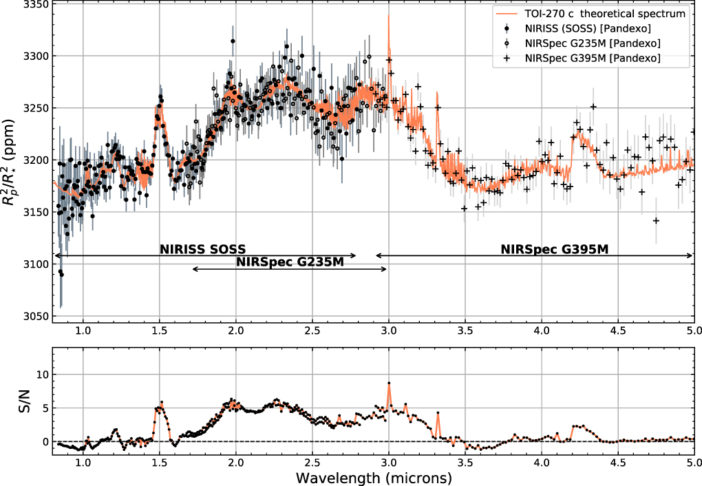Editor’s note: Astrobites is a graduate-student-run organization that digests astrophysical literature for undergraduate students. As part of the partnership between the AAS and astrobites, we occasionally repost astrobites content here at AAS Nova. We hope you enjoy this post from astrobites; the original can be viewed at astrobites.org.
Title: Detecting Biosignatures in the Atmospheres of Gas Dwarf Planets with the James Webb Space Telescope
Authors: Caprice Phillips et al.
First Author’s Institution: The Ohio State University
Status: Published in ApJ
Across the World, Astronomers Are Excited…
…because the latest “Great Observatory” was successfully launched into space! The space telescope known as JWST has become infamous amongst space professionals for long and frequent delays in its deployment since its conception in 1996. Though its timeline and price tag are daunting, they are but sxmall consequences of the telescope’s exquisite engineering and mind-blowing potential. Most often cited as the instrument that will allow us to look deeper into the past than ever before, JWST might also be able to search for potential signatures of life on planets outside our solar system! The authors of today’s article explain how.
A Portrait of an (Exo)World and Its Atmosphere
On Earth, we are protected from the adverse effects of our solar system (like flying rocks and too much radiation) by our atmosphere. While our rocky home has just enough gravity to hold on to an atmosphere of mostly nitrogen (N), planets slightly larger than Earth but smaller than Neptune would likely live in a bubble of hydrogen (H). Known as gaseous dwarf planets, these potential homes are easier to identify and study thanks to their larger sizes. Because of their hydrogen-dominated atmospheres, chemical reactions with hydrogen that produce molecules like ammonia (NH3) are expected to be common on these planets.
However, ammonia doesn’t occur spontaneously; it requires either extremely high temperatures and pressures or the existence of a reaction catalyst, potentially one that arose to support life-sustaining chemical processes. Furthermore, ammonia is easy to destroy in volcanic environments, meaning that the presence of ammonia suggests the presence of a process that regularly replenishes it. Therefore, in these worlds ammonia is a possible biosignature: a clue that the planet in question might be hosting life!
Unfortunately, the presence of ammonia alone isn’t enough to detect life outside the solar system, but it would set the stage for follow-up observations and even more amazing science. The authors of today’s paper begin by considering seven close-by exoplanets of the right size and temperature range to have gaseous envelopes and be observable by JWST. In this article, we’ll focus on one of the seven: TOI-270 c, which the authors find to be best suited for future JWST observations.
How Would We Search for Ammonia?
One method for determining the contents of a planet’s atmosphere is transmission spectroscopy: measuring the spectrum of the planet’s host star as its light filters through the planet’s atmosphere on its way to the detector. Ideally, the measured spectrum will reveal the tell-tale dips and peaks of absorption and emission spectra that are associated with individual elements and molecules. An example of the signature of ammonia from planet TOI-270 c is given in Figure 1. Note that there are several ammonia features we could potentially look for (at 1.0–1.5, 2.0, 2.3, and 3.0, as well as 5.5–6.5 and 10.3–10.8 µm, which are not shown) and that the height of the peaks depends on how much ammonia there is in the atmosphere in parts per million (ppm). The more ammonia there is, the easier it will be to detect!

Figure 1: The spectrum of ammonia in the atmosphere of TOI-270 c for different ammonia concentrations in parts per million (ppm). The height of the peak is given in terms of the ratio of the radius of the planet squared and the radius of the star squared (i.e., how much of the light is blocked). Note that there are at least six ammonia features to look for! [Phillips et al. 2021]

Figure 2: The spectrum of ammonia in the atmosphere of TOI-270 c as above, but now for different cloud decks. The most noticeable features emerge from an atmosphere with no clouds or with a cloud deck at 1.0 bar. Smaller features are noticeable in an atmosphere with a cloud deck at 0.1 bar, while a cloud deck at 0.01 bar flattens the spectrum to almost a straight line. [Phillips et al. 2021]
Could JWST See These Signals?
There are several instruments aboard JWST that could be used to hunt for ammonia-filled atmospheres; the authors find that Near-Infrared Spectrograph (NIRSpec) and the Near-Infrared Imager and Slitless Spectrograph (NIRISS) are particularly suitable. Together, these instruments cover the wavelength range of the ammonia features illustrated in Figures 1 and 2 above. The question is: are they sensitive enough to make the detection?
I won’t keep you in suspense: the authors’ results suggest that the answer is yes! The authors used two of their simulated spectra from above — assuming two different percentages of hydrogen in the atmosphere of TOI-270 c — and modeled what JWST observations of such an atmosphere might look like for 10 transits (see Figures 3 and 4). As might be expected, an atmosphere that is richer in hydrogen will produce a higher signal-to-noise ratio (S/N).

Figure 3: Top: The spectrum of ammonia in the atmosphere of TOI-270 c for an atmosphere rich in hydrogen is shown in orange, while the different black points show simulated JWST observations with NIRISS and two NIRSpec filters (G235M and G395). The authors also show the wavelength range of each of the instruments below the spectrum. Bottom: The signal-to-noise ratio of the simulated spectrum and observations. [Phillips et al. 2021]

Figure 4: The same figure as above, but this time with an atmosphere that is poorer in hydrogen. Note that this results in a lower signal-to-noise ratio than in Figure 3. [Phillips et al. 2021]
Conclusion
Under the right circumstances (hydrogen-rich atmosphere, lots of ammonia, no cloud deck), JWST is well-equipped to detect ammonia on gas dwarf planets — an exciting start on a long road towards determining whether we truly are alone in the universe!
Original astrobite edited by Lili Alderson.
About the author, Luna Zagorac:
I am a PhD candidate in the Physics Department at Yale University. My research focus is ultra-light (or fuzzy) dark matter in simulations and observations. I’m also a Franke Fellow in the Natural Sciences & Humanities at Yale working on a project on Egyptian archaeoastronomy, another passion of mine. When I’m not writing code or deciphering glyphs, I can usually be found reading, doodling, or drinking coffee.

